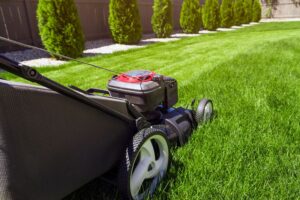For every homeowner with a sprawling green lawn, the riding lawn mower is a familiar and essential piece of equipment. However, like every machine, it requires periodic maintenance to function at its best. One such maintenance task is understanding how to deal with a loose mower deck belt. A loose or worn-out lawnmower belt affects the mower’s efficiency, often resulting in uneven cutting or complete stoppage. If you’d love to understand the intricate details of how to tighten mower deck belt, you are in luck! This post will ensure your mower deck operates smoothly with a tight lawn mower deck belt. From the pivotal role of the idler pulley to the nuances of belt tension, we’ll guide you step-by-step through the process.
You can also learn how to grow mints, how to water in heat season, or how to create a perfect soil circle here.
Safety Precautions
Before diving into the steps of tightening the mower deck belt, it’s vital to prioritize safety. The powerful mechanisms of a riding lawn mower pose a hazard if approached without caution. Here’s how to handle a safe belt adjustment process:
Power Down
Always turn off the lawn mower before beginning any maintenance task. It might seem elementary, but it’s a step some overlook in haste.
Spark Plug Disconnect
This is an added measure to ensure that the mower cannot accidentally start while you’re working. Removing the connection can prevent unintended engine starts.
Gloved Protection
Wearing gloves also protects your hands from the rough textures of the mower deck and belt and any accumulated oil, grease, or dirt.
Understand Your Mower
Before you adjust belt tension or fiddle with the idler pulley, it’s crucial to be familiar with your specific riding lawn mower model. Many mowers will have nuances in their design. So, consult the user manual for invaluable guidance.
Tools and Materials Needed
Before diving into the adjustments and inspections of your riding mower, gather the right tools and materials. These items not only ensure efficiency but also the safety and accuracy of your maintenance:
User Manual
This is your go-to guide, especially if you’re unfamiliar with your specific mower model. It provides details unique to your riding lawn mower, making tasks like adjusting the belt tension more straightforward.
Belt Deflection Tool
This tool is a handy instrument that measures the amount of give or “deflection” in mower belts. With a deflection tool, you can determine if the tension is right.
Set of Wrenches or Ratchets
The primary purpose of this tool is to adjust the belt tension to loosen or tighten parts connected to the belt system, like the swing arm.
Screwdrivers
It’s a handy tool for removing or adjusting components that may obstruct your view or access to the mower’s belt.
Clean Cloth or Rag
It’s useful for wiping down parts, especially if the lawnmower deck or drive belt is covered in debris or oil.
Flashlight or Work Light
This will assist in providing a clearer view, especially in the crevices of the mower deck.
Reference Videos
Consider checking out resources like “Steve’s Small Engine Saloon” on platforms like YouTube. They offer valuable visual aids for such tasks.
Inspect the Belt – Diagnosing Before Adjusting
Once you’re equipped with the right tools, it’s time to inspect the state of your mower belt. By properly diagnosing the belt’s condition, you can address the symptoms and the root cause of any belt issues.
Accessing the Belt
First, position the mower on a flat surface. Afterward, turn the steering wheel so that the front wheels point straight. Engage the mower deck lever to lower the lawnmower deck. This will give you easier access to view and assess the mower’s drive belt.
Visual Inspection
Examine the mower drive belt closely. Look for signs of wear like fraying, cracks, or visible damage. While lawnmowers are built for durability, mower belts still wear out over time due to constant tension and friction.
Feel the Tension
Using your hand or the belt deflection tool, press down gently on the belt. Notice how much it gives or deflects. If it feels too loose or overly tight, adjustments will be necessary. Remember, the right tension ensures the mower belt effectively transmits power from the engine to the blades.
Check the Tension Spring and Swing Arm
These components are crucial in maintaining belt tension on riding lawn mowers. So, examine them for any signs of malfunctioning and confirm that they are in good condition.
Drive Belt versus Deck Belt
Remember, riding mowers typically have two essential belts. The mower drive belt connects to the engine, and the mower deck belt connects to the blades. Make sure you are inspecting and adjusting the correct strap.
Locate the Belt Tensioner
For every riding lawnmower, the belt tensioner is the unsung hero, ensuring the lawnmower drive belt maintains its optimal tension. Think of it as the hearth extension dimensions for a wood floor – while not directly involved in the main function, it provides essential support. Here’s how to find and understand this pivotal component:
Consult the Manual
As always, the user manual for your specific mower model (a Cub Cadet or any other brand) offers precise guidance on locating the tensioner. Knowing your specific model saves time, given the variety of riding lawnmower designs.
Deck Engagement Lever
The belt tensioner is often associated with the deck or blade engagement lever. When this lever is moved, it adjusts the tension on a riding lawnmower’s drive belt, engaging or disengaging the mower blades.
Visual Inspection
Look for a pulley or wheel-like component that moves when the deck engagement lever is adjusted. Nearby, you should also identify a tension spring that aids in maintaining the belt’s tension.
Tightening Procedure
With a worn-out belt, your mower’s cutting blades can’t rotate efficiently, affecting your lawn’s appearance and the mower’s performance. To tighten it, follow the following process:
- Safety First: Ensure the mower is off and you’ve taken precautions, such as disconnecting the spark plug.
- Bracket Screws: Start by slightly loosening (but not removing) the bracket screws associated with the belt tensioner using a socket wrench. This will allow you to adjust the tensioner without entirely dismounting it.
- Adjust the Tensioner: Push or pull the belt tensioner to increase or decrease the tension on the mower’s belt. If unsure about the correct pressure, refer to your mower’s manual or use a belt deflection tool.
- Belt Keeper Check: This component ensures the belt remains in place. Confirm it’s correctly positioned to avoid the belt from slipping out of the pulley system.
- Tighten the Bracket Screws: Once the belt’s tension is satisfied, retighten the bracket screws to secure the tensioner in its adjusted position.
- Recheck the Belt: Rotate the mower blades manually for the smooth movement of the belt. This rotation will help you ascertain if the tension is adequate and if there’s any impediment.
- Cautionary Note: Always use the correct belt size for your mower. A wrong belt size leads to premature wear or even damage to the mower components.
Recheck Belt Tension
After making adjustments or replacing a worn belt with a new belt, it’s crucial to recheck the tension to guarantee that your drive belts are set up correctly for optimal performance.
Physical Test
A common method to check the belt tension is the finger test. Press down on the belt midway between the engine pulley and one of the idler pulleys. Using one or two fingers, you should be able to depress the belt slightly, typically within a range of one or two pounds of force. The belt should have some give but not feel overly slack or extremely tight.
Synchronous Belts
If your riding mower uses synchronous belts to maintain a constant speed ratio between the pulleys, confirm they’re seated properly within their grooves. These belts require precise tension to work efficiently.
Consult the Owner’s Manual
As each mower model might have specifics, always refer to the owner’s manual for guidance on proper belt tension.
Look for Any Inconsistencies
Check that the new belt is aligned correctly with all pulleys, even if it’s the same belt type as the worn belt. Misalignment causes premature wear and inefficient operation.
Reconnect and Test
After adjusting and rechecking the belt tension, it’s time to reconnect any disengaged parts and test the mower’s performance.
Reconnect the Spark Plug
You can’t start your mower without the spark plug. Hence, always remember to reconnect it after any maintenance procedure.
Start the Mower
Turn on the riding mower and carefully listen for any unusual noises. A correctly tensioned belt should operate smoothly without any squealing or screeching sounds.
Engage the Blades
Using the blade engagement lever, engage the mower blades. Check to see if they rotate smoothly and consistently. If you notice any hitches or pauses in rotation, it might mean the engagement spring needs to be tighter, or there might be another underlying issue.
Monitor the Idler Pulleys
As the mower runs, check the idler pulley rotation for obstructions or hitches. These components are crucial in maintaining the belt’s tension and should be free from hindrances.
Considerations and Tips

Regular Maintenance
Like any machine, routine checks and maintenance of your riding mower help identify issues early and prolong its lifespan.
Quality Over Price
When replacing belts, always choose quality over cheaper alternatives. A premium belt might cost more initially, but it will likely outlast and outperform cheaper counterparts, resulting in savings in the long run.
Stay Informed
Continuously educate yourself on your mower model. Manufacturers often release updates or recommendations that can be invaluable.
Seasonal Storage
If you store your mower during off-seasons, always confirm that the belts are relaxed, preventing them from stretching or becoming distorted over time.
Safety First
Never compromise on safety. Whether disconnecting the spark plug or wearing gloves, always prioritize your safety and those around you.
Seek Expertise
Don’t hesitate to consult an expert or technician if ever in doubt. Sometimes, the most straightforward solutions come from those who handle such machines daily.
Conclusion
Tightening the mower deck belt is more than just a maintenance task. It’s a way to ensure the longevity and efficiency of your prized riding lawn mower. Remember, as with all tasks, knowledge combined with precaution ensures success and safety.



